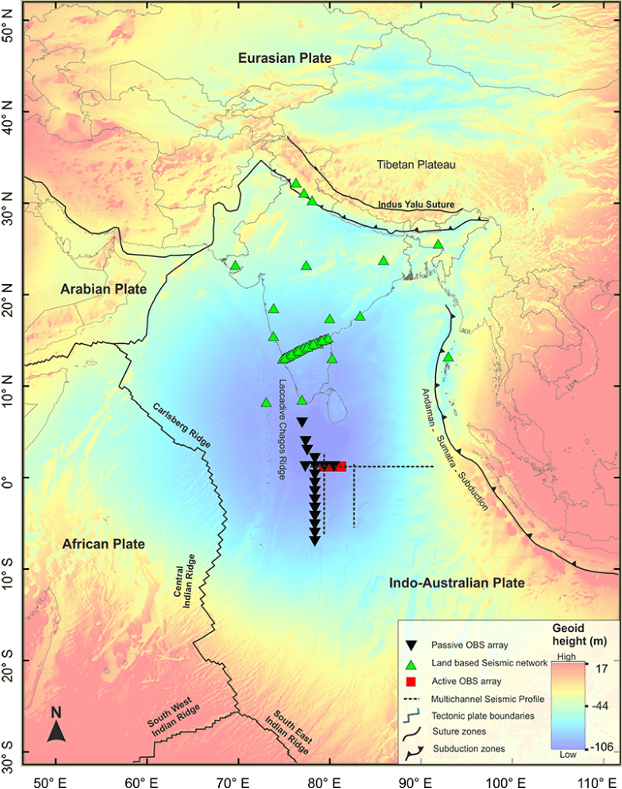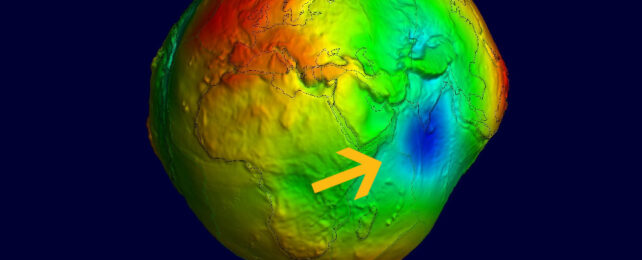Gravity's pull is a constant on Earth, but our planet is no uniform sphere. It's covered in lumps and bumps, with geology of varying density yanking on nearby masses with subtly differing degrees of force in an undulating map known as a geoid.
Deep beneath the Indian Ocean, that pull weakens to an extreme low, leaving what is considered a massive gravity 'hole' some three million square kilometers in size roughly where the seafloor sinks into a vast depression.
One of the most profound gravitational anomalies on Earth, its presence has been alluded to for a while. Ship-based surveys and satellite measurements revealed long ago that the sea level just off the tip of the Indian subcontinent dipped on account of the gravitational tug-of-war between the aptly named Indian Ocean geoid low and the surrounding gravitational 'highs'.
Just what caused this relative weakening has never been clear. Now two researchers from the Indian Institute of Science think they have a better idea of the kinds of planetary phenomena that could be involved.
"All these [past] studies looked at the present-day anomaly and were not concerned with how this geoid low came into existence," geoscientists Debanjan Pal and Attreyee Ghosh explain in their published paper, which describes their new working hypothesis.
They think the answer lies more than 1,000 kilometers (621 miles) beneath Earth's crust, where the cold, dense remnants of an ancient ocean plunged into a 'slab graveyard' beneath Africa some 30 million years ago, stirring up hot molten rock.
But their results, based on computer models, are unlikely to settle a fiery debate about the geoid low's origins – at least not until more data is collected.
In 2018, a shipload of scientists from India's National Centre for Polar and Ocean Research set out to deploy a string of seismometers along the seafloor of the deformation zone, to map the area.
Being so far offshore, little seismic data had been collected in the area before. The results from that 2018 survey pointed to the presence of hot plumes of molten rock rising up beneath the Indian Ocean and somehow contributing to its great dent.

But a longer view was needed to reconstruct the geoid low in its early phases. So Pal and Ghosh retraced the formation of the massive geoid by modeling how tectonic plates skimmed over Earth's hot, gooey mantle during the past 140 million years.
Back then, the Indian tectonic plate was just starting to break away from the supercontinent, Gondwana, to begin its northward march. As the Indian plate advanced, the seabed of an ancient ocean called the Tethys Sea sank into Earth's mantle, and the Indian Ocean opened up behind it.
Pal and Ghosh ran simulations using more than a dozen computer models of plate motion and mantle movements, comparing the shape of the oceanic low those models predicted with observations of the dent itself.
The models that reproduced the Indian Ocean geoid low in its current form all had one thing in common: plumes of hot, low-density magma wafting up beneath the low. These plumes, in addition to a distinctive mantle structure, are what created the geoid low; if they rise high enough, Pal and Ghosh surmise.
"In short, our results suggest that to match the [shape and amplitude of the] observed geoid low, plumes need to be buoyant enough to come up to mid-mantle depths," the pair writes.
The first of these plumes appeared about 20 million years ago, to the south of the Indian Ocean geoid low, and around 10 million years after the old Tethys Sea sank into the lower mantle. As the plumes spread beneath the lithosphere and inched towards the Indian peninsula, the low intensified.

Given their results are consistent with elements of Ghosh's previous modeling work from 2017, the duo suggests the telltale plumes were thrust up after the Tethys seafloor sank into the lower mantle, disturbing the famed 'African blob'.
However, some researchers not involved in the work aren't convinced, telling New Scientist there isn't any clear seismographic evidence yet that the simulated plumes are actually present beneath the Indian Ocean.
Such data may soon come to light, and there's no rush really – the geoid low is expected to persist for many more millions of years yet.
The study has been published in Geophysical Research Letters.
